Mastering Smoked Turkey: Ideal Temperatures Explained
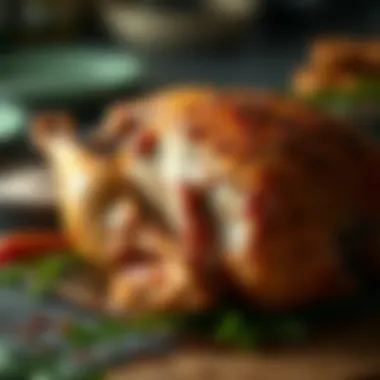
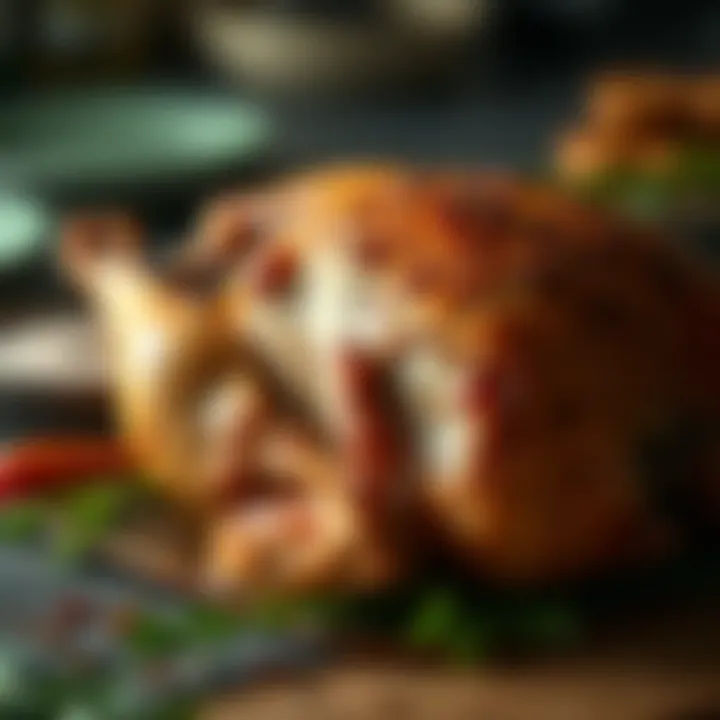
Intro
Smoking turkey is more than just a culinary technique; it's a tradition that warms the heart and tantalizes the taste buds. If you want to transform a humble bird into a masterpiece, understanding temperature is the key. This article will guide you through the ins and outs of smoking turkey, particularly focusing on the critical temperatures required to achieve mouthwatering results.
Most cooks don’t realize how vital the correct temperature is. Get it wrong, and you might be left with a bird that could rival a hockey puck for texture. But fret not! By the end, you will have a firm grasp on heat management, ensuring your turkey comes out tender, juicy, and full of flavor every time.
In addition to tackling temperature, this guide will highlight common mistakes that can trip up even seasoned cooks. You’ll learn how to keep your food safe while smoking, so everyone can enjoy your scrumptious offering without worry. With a sprinkle of diligence and a dash of know-how, you’ll be able to elevate your turkey dishes like never before.
Understanding Smoked Turkey
When diving into the world of smoked turkey, it becomes clear that this culinary approach is more than just a cooking method; it’s a preservation technique, an art form, and a cultural staple that offers a unique depth of flavor. Understanding smoked turkey means not only grasping the technical aspects of the cooking process but also appreciating the sensory experiences it provides—the aroma of wood burning, the sight of smoke curling through the air, and of course, that rich, savory taste that dances on the palate.
The appeal of smoked turkey is multi-faceted. First off, it brings a creative flair to the table. Unlike other cooking methods, smoking infuses the turkey with flavors that are distinctive and varied, depending on the wood used. For instance, hickory offers a robust richness, while fruit woods like apple or cherry add a subtle sweetness. This versatility allows home cooks to tailor their dishes to personal tastes, celebrating individual preferences in a way that traditional roasting simply cannot.
Moreover, smoked turkey often holds a nostalgic value for many. It recalls memories of family gatherings, holidays, or backyard barbecues where the tantalizing aroma of meat smoking wafts through the air, inviting everyone to partake in something special. By understanding this tradition and the relationship between smoke and meat, cooks can create dishes that not only satisfy hunger but also evoke fond memories.
However, it's critical to approach smoking with the proper knowledge. Various factors come into play when smoking turkey, including temperature, type of smoker, and the duration of smoke exposure. These factors must be finely tuned to produce a tender, flavorful bird that is safe for consumption. In essence, understanding smoked turkey lays the foundation for mastering this technique, allowing cooks to avoid pitfalls and embrace the joy of crafting a perfectly smoked dish.
The Appeal of Smoked Turkey
The charm of smoked turkey lies in its complex flavor profile and the versatility it offers. It’s not just about throwing a bird into a smoker; it’s about the nuances at play. The combination of slow cooking, smoke infusion, and judicious seasoning creates a meal that can be enjoyed in myriad forms. From smoky sandwiches piled high with slices of turkey to elegant dinner plates adorned with smoked turkey breast and cranberry sauce, the options are endless.
Moreover, the appeal stretches beyond mere flavor. Smoking turkey transforms something ordinary into an exceptional dish, encouraging cooks of all skill levels to experiment. Whether one is seasoning a turkey with a homemade rub or trying out different wood chips, the process invites a spirit of creativity. One could say that smoking turkey is akin to painting a masterpiece, where the base canvas is the bird and every element added—spices, smoke, time—adds detail that elevates the dish as a whole.
Historical Context of Smoking Meats
Smoking meats, including turkey, dates back centuries, serving as a method for preservation long before refrigeration was a twinkle in anyone's eye. Early civilizations recognized that smoke not only added flavor but also acted as a natural preservative, deterring spoilage and offering an effective means to store food.
In many cultures, smoking was a communal activity. People would gather to prepare meats for winter months, sharing techniques that would be passed down through generations. Different woods were chosen based on what was readily available, leading to an array of regional smoking traditions that continue today. For example, the Southern United States has popularized the use of hickory, while the Pacific Northwest might lean more towards alder or maple.
The evolution of smoking meats reflects broader culinary trends. What was once a necessity has transformed into an art form celebrated in culinary competitions and showcased in restaurants worldwide. Understanding this historical context enriches the process of smoking turkey, creating a deeper appreciation for each bite, and connecting today’s cooks with the generations that have come before them.
The Science of Temperature in Cooking
Cooking, at its core, is a dance of heat and time. This becomes especially evident when smoking turkey. The importance of temperature in this culinary art cannot be overstated. Mastering the nuances of heat allows a cook to transform an ordinary turkey into a flavorful, tender masterpiece. Knowledge of how different temperatures impact the cooking process can make the difference between a juicy bird and a dried-out flop.
In the realm of smoked turkey, the relationship between temperature and time plays a vital role. When you smoke turkey, you aren’t just cooking it; you are coaxing out flavors, moisture, and creating that coveted smoky profile. Each degree can influence how proteins break down and how fat renders, and this is where the magic happens. A precise temperature can mean the difference between achieving the perfect crust and overcooking the meat. It’s about finding that sweet spot where you develop flavor without crossing the line into dryness.
Why Temperature Matters
Temperature matters in cooking for multiple reasons. First, it ensures that harmful bacteria are eliminated, making it safe to eat. For turkey, reaching an internal temperature of 165°F (74°C) is crucial. But let’s peel back the layers; just reaching this threshold isn't the whole story. It’s recommended that the meat be held at the ideal temperature for a certain duration to ensure not just safety, but also that the turkey is succulent and flavorful.
Moreover, varying smoker types require different temperature adjustments. Knowing how to control your smoker’s heat is a game changer in achieving that perfect smoked turkey. Remember, low and slow is the mantra here, but it needs to be coupled with a solid understanding of how heat affects your bird.
Here are a few extra points to keep in mind:
- Bacterial Growth: The risk of foodborne illnesses increases significantly between 40°F and 140°F (4°C and 60°C). Maintaining turkey at safe temperatures during the cooking process is paramount.
- Cooking Time: Lower temperatures mean longer cooking times. It’s a balancing act between temp and time to ensure a flavorful outcome.
- Smoky Flavor: Best flavors come alive when smoking ranges between 225°F and 275°F (107°C and 135°C).
How Temperature Affects Flavor and Texture
The impact of temperature on flavor and texture is not just about cooking the bird through; it’s about inviting the turkey to develop a rich tapestry of tastes. When turkey is smoked at lower temperatures, the meat tends to absorb more smoke, resulting in a deeper, smokier flavor. Heat also affects the protein structure within the meat.
Here’s how different cooking temperatures influence your turkey:
- Low Temperatures (225°F to 275°F): This range allows for moisture retention, breaking down connective tissues. The longer cooking process results in melt-in-your-mouth tenderness, ideal for smoking.
- Medium Temperatures (275°F to 350°F): While you still maintain moisture, you might lose some of that deeper smoky flavor you’d get from lower cooking. It's a trade-off, yet you might achieve a beautiful crisp skin faster.
- Crispy Exterior (350°F and above): Higher temps can create a crisp exterior quickly but risk drying out the tender interior if not carefully monitored.
In short, lower temperatures allow for a richer flavor that penetrates the meat while also keeping it tender. On the contrary, higher temperatures may give a pleasing texture but could sacrifice moisture, leaving the turkey less enjoyable.
"Achieving the perfect smoked turkey is less of a recipe and more of a science, where temperature reigns supreme."
By understanding these principles, you will not only ensure a safe and satisfying meal but also embark on a flavorful journey that enhances your smoked turkey experience.


Ideal Temperature for Smoked Turkey
When it comes to smoking turkey, hitting the right temperature is akin to finding the keys to a treasure chest. It is crucial not only for the taste but also for safety. Cooking turkey isn’t just about getting it juicy and flavorful; it’s also about ensuring that the meat is safe to eat. Under or overcooking your turkey can lead to some serious off-putting results, both in flavor and health risks. This section breaks down the recommended temperatures, suitable for different smoking techniques, and how to achieve the tantalizing smoky goodness we desire while keeping safety at the forefront.
Recommended Internal Temperatures
The internal temperature of smoked turkey is the gold standard for achieving that perfect bite and texture. The USDA recommends that turkey should reach a minimum internal temperature of 165°F (74°C) in the thickest part of the breast and inner thigh. However, to enhance tenderness and flavor, many pitmasters recommend cooking turkey to around 175°F (80°C) to allow connective tissues to break down. This extra cooking can make the meat more succulent and enjoyable, elevating your smoked turkey from mediocre to unforgettable.
- 165°F (74°C): This is the safe zone; reaching this temp means the turkey is safe to eat.
- 175°F (80°C): This is where the magic happens, leading to juicier, more flavorful turkey.
Furthermore, it’s worth mentioning that not all turkeys are created equal. The size and even the type of turkey can affect how heat penetrates. Hence, investing in a good meat thermometer is invaluable. You want to be sure you’re not just guessing at the temperatures, as cooking styles can differ widely.
Target Cooking Temperatures by Type of Smoker
Smoking turkey can be done in various ways, and each method comes with its own quirks and temperature parameters. Let’s break down the different types of smokers and their recommended cooking temperatures:
Charcoal Smokers
Charcoal smokers are beloved among many seasoned grillers. The specific aspect of a charcoal smoker is the ability to infuse your turkey with deep, rich flavors thanks to the wood chips that can be used alongside the charcoal. Typically, when using a charcoal smoker, you’d aim for a consistent cooking temperature between 225°F to 250°F (107°C to 121°C). This low and slow approach allows the meat to absorb all that smoky goodness while ensuring a well-cooked interior.
- Key Characteristic: The smoke flavor is often unmatched due to the natural burning of wood and charcoal together.
- Unique Feature: Charcoal provides heat that is less predictable than electric smokers, requiring constant monitoring and adjustments, a task some pitmasters relish.
Although it requires a bit of experience and attention, many find the results incredibly rewarding.
Electric Smokers
Electric smokers represent a more straightforward approach to smoking, catering especially to novices who want to minimize the hassle. This method typically maintains a consistent temperature with minimal effort. The target cooking temperatures typically range between 225°F to 275°F (107°C to 135°C). The ability to set a regulated heat makes it easier to manage cooking time.
- Key Characteristic: The electric setup is user-friendly and great for those new to smoking.
- Unique Feature: Letting the machine do most of the work means more time for other preparations, especially if you’re hosting a gathering.
However, while this method is convenient, some aficionados argue it lacks the depth of flavor that a charcoal smoker might offer.
Pellet Smokers
Pellet smokers are gaining traction among many cooking enthusiasts, providing a unique blend of wood flavoring and the convenience of electric cooking. The specific aspect of pellet smokers is their ability to automatically feed wood pellets into the fire, regulating temperature with ease. Optimal smoking temperatures here are around 225°F to 260°F (107°C to 127°C).
- Key Characteristic: They offer a great balance of flavor and control, making them versatile.
- Unique Feature: The combination of smoking and grilling allows for various cooking styles in a single device, which can be particularly useful for those wanting flexibility.
Despite their reliability and ease of use, some purists may view pellet smoking as a slightly more compromised authenticity in flavor compared to traditional methods.
Ultimately, whether you’re using a charcoal, electric, or pellet smoker, understanding the ideal cooking temperatures is pivotal. It sets the stage for achieving a smoked turkey that is not only safe but also tantalizingly delicious, aligning with the preferences of any discerning palate.
Common Temperature Mistakes
When it comes to smoking turkey, the temperature plays an integral role in determining the success of the dish. Understanding common mistakes related to temperature can make or break your smoked turkey experience. Many skilled cooks still fall prey to missteps that affect the end product without even realizing it. It’s vital to recognize these pitfalls to ensure a juicy, delicious turkey every time you smoke.
Overcooking: Risks and Consequences
Overcooking turkey is one of the most common blunders you can make. It may sound simple, but a turkey that spends too much time in the smoker can turn from succulent to dry quicker than you can say, "carve the turkey!" Ideally, you'd want a fluffy, moist bird, but get that temperature too high for too long, and you risk turning your prized bird into a stringy mess.
- Texture Changes: Once the turkey exceeds its ideal internal temperature—around 165°F for white meat—the proteins start to unwind and lose moisture. This leads to a rubbery texture that is far from appetizing.
- Flavor Dissipation: The fluctuations in temperature can also strip away the rich, smoky flavor you worked hard to develop. Instead of a deep, savory taste, you might end up with a dull, one-dimensional turkey.
- Visual Appeal: An overcooked turkey can look unappealing, too. When the meat is dry, it typically loses its enticing golden-brown color and appears shriveled instead. Given that we famously eat with our eyes first, this might dampen your guests' enthusiasm.
The best way to avoid overcooking is to continuously monitor your turkey's internal temperature closely using a reliable meat thermometer. Remember, it’s better to check frequently as you get closer to your target temperature.
Undercooking: Ensuring Food Safety
Conversely, undercooking turkey presents its own set of challenges. This blunder can lead to serious health issues, primarily due to foodborne pathogens that thrive at the lower temperature ranges.
- The Danger Zone: The USDA defines a danger zone between 40°F and 140°F. When your turkey hangs around in this range too long, it creates a welcoming environment for bacteria. Undercooked turkey can contain Salmonella or Campylobacter, making it hazardous to consume.
- Achieving Safe Temperature: To ensure your turkey is safe to eat, internal temperatures should consistently hit 165°F throughout. This is particularly crucial in the thickest parts of the bird, such as the breast and thighs. A simple test is to insert the thermometer into these areas before serving, and not just the meat closest to the smoker's heat source.
- Effects on Texture and Flavor: An undercooked turkey affects not just safety, but also the overall texture and flavor as well. The meat may remain rubbery and unpleasant, leaving a bad taste and potentially ruining the meal.
It's important to remember that adding a little patience and attentiveness at this stage will safeguard your dish from both culinary and health-related mistakes. Treat your turkey well, and it'll pay you back with flavor and satisfaction, instead of sending guests fleeing for the nearest fast-food joint!
"Perfectly smoked turkey is all about nailing that temperature, not just for flavor, but for safety, too!"
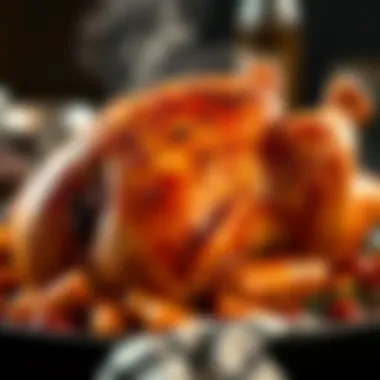
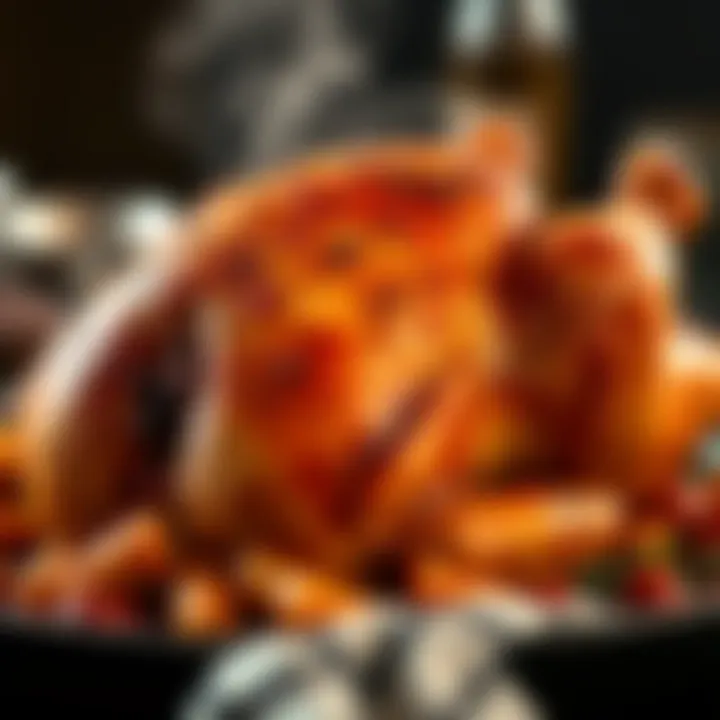
By understanding the risks of overcooking and undercooking, you’re well on your way to mastering the art of smoked turkey. Keeping these common temperature mistakes at bay serves not just to enhance your cooking skills but also ensures a wonderful experience for all who dine at your table.
Temperature Control Techniques
When it comes to smoking turkey, mastering temperature control is crucial. The delicate balance of heat influences both the cooking process and the flavor development of the meat. Without proper temperature management, all the hard graft in selecting marinades, wood types, and turkey cuts can be for naught.
This section will offer insights into using meat thermometers effectively and controlling smoker temperatures – two key pieces of the puzzle that will ensure your turkey comes out juicy and flavorful every time.
Using a Meat Thermometer
A meat thermometer might seem like a simple tool, but it plays a pivotal role in achieving a perfectly cooked smoked turkey.
Types of Meat Thermometers
There are several types of meat thermometers, each contributing uniquely to your cooking experience. The most common categories include:
- Digital thermometers: These provide a quick readout and are generally recognized for their accuracy. Many come with features like backlit displays for easy reading in low light.
- Analog thermometers: Known for their simplicity, these can still do the trick, but they might take longer to give an accurate temperature reading.
- Probe thermometers: Useful for leaving in the meat while it cooks, allowing you to monitor the temperature from a distance.
What makes the digital style a popular choice is its speed and ease of use. They show the temperature in a matter of seconds, giving you peace of mind as the turkey cooks. However, it’s worth noting that digital models may require battery replacements, which could be an inconvenience during prolonged cooking sessions.
Placement for Accuracy
Placement of the thermometer probe is another critical aspect that can’t be overlooked. It’s not just about sticking it in and hoping for the best. To get an accurate reading, the probe should be placed in the thickest part of the turkey breast, avoiding the bone.
This positioning is beneficial because:
- Prevents Overcooking: Knowing the internal temperature of the meat ensures that you don’t overcook the turkey, which can lead to dryness.
- Enhances Flavor: You’re more likely to achieve the perfect balance in taste and texture if you can monitor the internal environment effectively.
Misplacing the thermometer can result in misleading readings, leading you to underestimate or overestimate how done your turkey is. And trust me, nobody wants to serve a dry bird at their dinner table! While it may seem tedious to ensure correct placement, the difference in outcome is well worth the effort.
Adjusting Smoker Temperatures
Mastering the art of adjusting smoker temperatures can feel like a dance at times. Each smoker behaves differently depending on its fuel source and design. This adaptability is critical if you’re looking to keep the turkey cooking evenly.
When utilizing a charcoal smoker, for example, you might need to manage airflow efficiently; opening vents can increase the heat, while closing them reduces it. In contrast, electric and pellet smokers are often more straightforward. They tend to maintain consistent temperatures but still require occasional adjustments based on the cooking environment.
Here, maintaining the ideal smoking temperature can define your success. It’s advisable to check the smoker regularly, adjusting vents, and adding fuel as needed, so the temperature remains stable throughout the cooking process.
Marinating and Seasoning for Optimal Flavor
When it comes to smoking turkey, marinating and seasoning play crucial roles in not only enhancing the flavor but also ensuring moisture retention and tenderness. This section delves into how well-prepared marinades and chosen seasonings can elevate your smoked turkey experience, bringing out rich, complex flavors that elevate the dish beyond the ordinary.
The Role of Marinades
Marinating serves as a transformative process. When you soak your turkey in a marinade, you’re not just adding flavor on the surface. The science of marinating involves breaking down the meat fibers, which allows the flavors to penetrate deeper into the turkey, fostering an unctuous mouthfeel that can make your dish truly memorable. To keep things interesting, think of your marinade as a canvas.
A good marinade typically consists of several key components:
- Acid: Ingredients like vinegar, citrus juice, or wine break down proteins, making turkey tender.
- Oil: Olive oil or any neutral oil helps in flavor absorption and moisture retention.
- Seasonings: Garlic, herbs, spices—they're your soldiers in the flavor wars. These can vary widely, so feel free to experiment!
- Sweetener (optional): A hint of honey or brown sugar can bring out a caramelized flavor when smoked.
Overall, letting your turkey marinate for at least four hours, or better yet, overnight, allows for optimal flavor infusion.
Best Seasoning Combinations
Selecting the right seasonings for your smoked turkey can be the difference between a well-seasoned feast and a flavorless fowl. Here's where creativity shines. Common seasoning combos tend to focus on complementing the natural flavor of the turkey, creating a symphony for the taste buds. Here are some recommendations you might want to consider:
- Herb Medley: A blend of rosemary, thyme, and sage creates an aromatic profile that shines when smoked.
- Spicy Kick: Incorporate paprika, cayenne pepper, and black pepper for those who appreciate some heat.
- Sweet and Savory: Pair brown sugar or maple sugar with garlic and onion powder to balance sweetness with savory notes.
- Citrus Zest: A sprinkle of lemon or orange zest can add brightness, enhancing the turkey's flavor without overpowering it.
When applying your seasonings, don’t skimp. A generous hand ensures every bite bursts with flavor. Remember to rub the spices not just on the surface, but also beneath the skin for immortal flavor.
"Good seasoning is like a gentle whisper; it enhances the turkey without stealing the show."
Post-Smoking Considerations
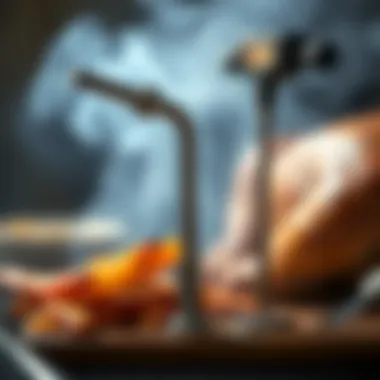
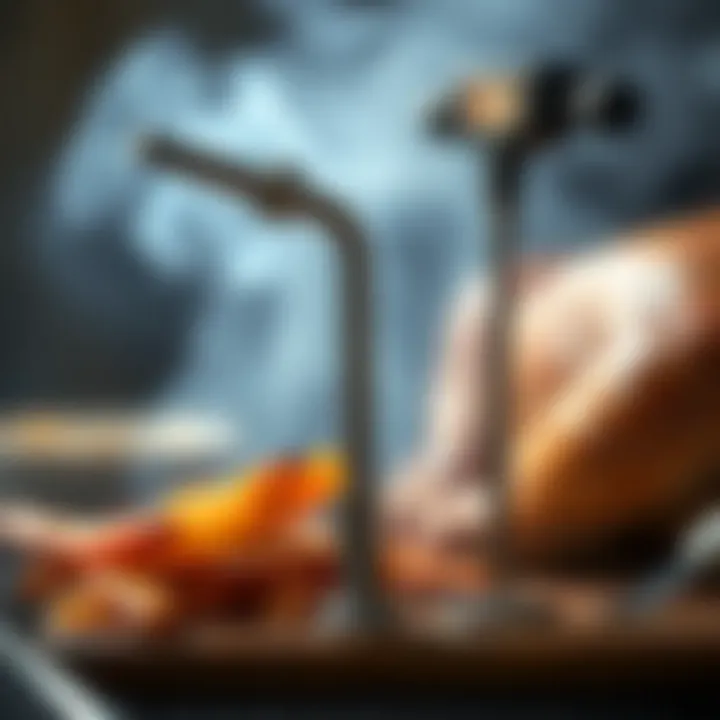
Post-smoking is a crucial phase in the smoking process, often underestimated by both novice and experienced cooks alike. The significance of this stage cannot be overstated, as it directly influences the texture and flavor of the finished turkey. Hasty cooks might be tempted to slice the turkey as soon as it comes off the smoker, but this rush can lead to a less-than-ideal meal. Understanding the dynamics at play during this phase can elevate your smoked turkey from good to phenomenal.
Resting the Turkey
The Importance of Resting
Allowing the turkey to rest after smoking is not just a recommended step; it's essential for the final result. Resting involves letting the meat sit for a certain period, which permits the juices that have been forced towards the center during cooking to redistribute throughout the turkey. If you skip this step, you'll likely end up with dry slices, as cutting into the meat right away causes those juices to run out, leaving you with a parched and flavorless dish.
The beauty of resting lies in its simplicity and effectiveness. For turkey, a resting time of at least 30 minutes is commonly suggested. This time allows the flavors to meld together, making the meat not only juicier but also more flavorful. Additionally, resting contributes to a reduction in carryover cooking, which can affect the overall texture if the turkey continues to cook after being removed from the smoker. It’s a game changer.
Timing the Rest Period
It's not enough to simply let your turkey rest; the timing can make a significant difference. Generally, you'll want to aim for a resting period of about 30 to 45 minutes after smoking. This is long enough to encourage moisture retention without allowing the turkey to cool down too much. In fact, the timing of the rest period should be adjusted based on the size of your turkey. For a smaller bird, 30 minutes should suffice, while larger turkeys may benefit from a longer 45-minute resting period.
A unique feature of this timing is that it gives you a buffer to prepare side dishes or finish off any other meal components, providing a seamless cooking experience. However, be aware that if the turkey is left to rest for too long—say an hour or more—it could start cooling off excessively, making it less enjoyable to eat.
Slicing and Serving Techniques
Slicing and serving aren’t just procedural tasks; the way you approach them can further enhance your turkey’s appeal. To achieve a beautiful presentation, utilize a sharp knife and cut against the grain. This technique aids in obtaining tender slices, which are less likely to tear.
When it comes to serving, consider the following methods:
- Plate Presentation: Arrange the slices neatly on a platter, perhaps garnished with herbs or seasonal vegetables for visual appeal.
- Temperature Control: Serve the sliced turkey warm. If you need to keep it warm, consider covering the platter with aluminum foil to prevent excessive heat loss.
As you serve your smoked turkey, it often helps to include a homemade sauce or gravy by saving the drippings collected in the smoking process. This delivers yet another layer of flavor and elevates the dining experience.
Health and Safety Precautions
When it comes to smoking turkey, health and safety considerations cannot be thrown out the window. This is particularly crucial because improperly handled meat can lead to serious foodborne illnesses, which are not just a bother but can result in severe health consequences. Understanding food safety precautions not only protects you and your guests but also enhances the overall cooking experience. The combination of deliciousness and safety creates the perfect harmony that every cook strives for.
Understanding Foodborne Illness Risks
The risks associated with foodborne illnesses are often underestimated. When smoking turkey, it's necessary to comprehend that pathogens thrive at temperatures between 40°F and 140°F, a range known as the "danger zone." If you’re not careful, the delicious turkey you plan to serve could become a breeding ground for bacteria. Common offenders include salmonella and E. coli, both of which are capable of causing serious ailments.
"An ounce of prevention is worth a pound of cure."
Keeping your turkey out of the danger zone is one of the easiest ways to minimize the risk of these illnesses. Always aim to keep your meat refrigerated at or below 40°F before cooking and ensure that it reaches an internal temperature of at least 165°F during smoking.
If you’re reheating turkey leftovers, likewise be sure to heat them to 165°F as well to ensure any lingering pathogens are eliminated. Ignoring these basic principles can lead to unwanted health surprises.
Best Practices for Smoker Hygiene
Maintaining a clean smoker is paramount for safe cooking. Without proper hygiene, even the best-smoked turkey could become contaminated. Just as a clean kitchen promotes better cooking, a clean smoking environment does the same for your meat.
- Clean Thoroughly Before Use:
Start with a thoroughly cleaned smoker. Remove any grease or leftover residue from previous cooks, as these can harbor harmful bacteria. - Use Separation:
Avoid cross-contamination by using separate utensils and cutting boards for raw turkey and other ingredients. Don’t let raw turkey juice come into contact with anything that won't be cooked, such as vegetables. - Temperature Checks:
Regularly check the temperature inside your smoker. If the smoker isn’t functioning properly, it can allow harmful bacteria to thrive. - Proper Storage After Cooking:
Once your turkey is done, store any leftovers promptly in the fridge. Ensure they cool down to room temperature quickly, but don’t let them linger too long outside of the smoker to avoid getting into that danger zone again. - Regular Maintenance:
Clean your smoker after every use. Regular maintenance not only ensures cleanliness but also promotes a smoother cooking experience.
By adhering to these best practices for smoker hygiene, you can significantly reduce the risk of foodborne illnesses while still enjoying the delightful flavors of smoked turkey. Understanding these crucial aspects lays the groundwork for a satisfying and safe culinary journey.
Closure
Wrapping up this exploration of smoked turkey temperatures, it’s clear that knowing the right temperatures is critical for achieving a mouthwatering dish. From ensuring food safety to enhancing flavor, this knowledge forms the backbone of successful smoking. Each component discussed throughout the article, from the ideal internal temperatures to the control techniques, offers a building block for culinary excellence.
When you grasp the significance of temperature, you’re not just cooking; you’re crafting an experience that invites enjoyment and satisfaction. This means understanding at what temperatures your turkey should be smoked creates a pathway to moist, flavorful results.
More than just a number on a thermometer, the right temperature leverages the scientific principles of cooking to make each bite tender, juicy, and bursting with flavor. In a way, each smoked turkey becomes a masterpiece, uniting technique with artistry. Therefore, keeping a close eye on these temperatures isn’t just advisable; it’s essential.
Recap of Key Points
- Ideal internal temperature for smoked turkey is between 165°F (73°C) and 175°F (80°C).
- Common mistakes involve both overcooking and undercooking, which can lead to dry meat or health risks.
- Using a meat thermometer and adjusting smoker temperature are fundamental techniques for achieving desired results.
- Proper marinating and seasoning further enhance the smoking process by adding depth of flavor.
- Always rest your turkey post-smoke to allow juices to redistribute, ensuring each slice is juicy and tender.
With these key points in mind, you can approach your next smoking endeavor with confidence and a heart full of culinary ambition.
Encouragement for Experimentation
Don’t shy away from taking risks in your cooking adventures. Embrace the art of smoking turkey as an opportunity to experiment with flavors, techniques, and even wood types for smoking. Each try offers a new lesson, new flavor combinations, and chances to fantastically tweak the variables until it echoes your unique palate.
Experimentation can lead to surprising results that become your signature touch. Have you ever considered a twist like a maple syrup glaze or perhaps incorporating fruit woods such as apple or cherry for that sweet finish? The sky’s the limit!
So, don’t just follow the guide; let your creativity flourish. With each smoking session, you’re not just cooking, you’re innovating and crafting dishes that could wow any crowd.
As you dive into the world of smoked turkey, remember that it’s not about perfection but progress. Taste is subjective, and what matters most is that you find joy in this experience. Happy smoking!















